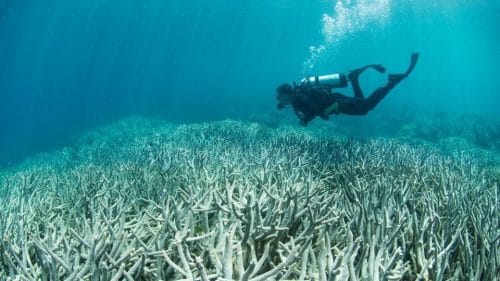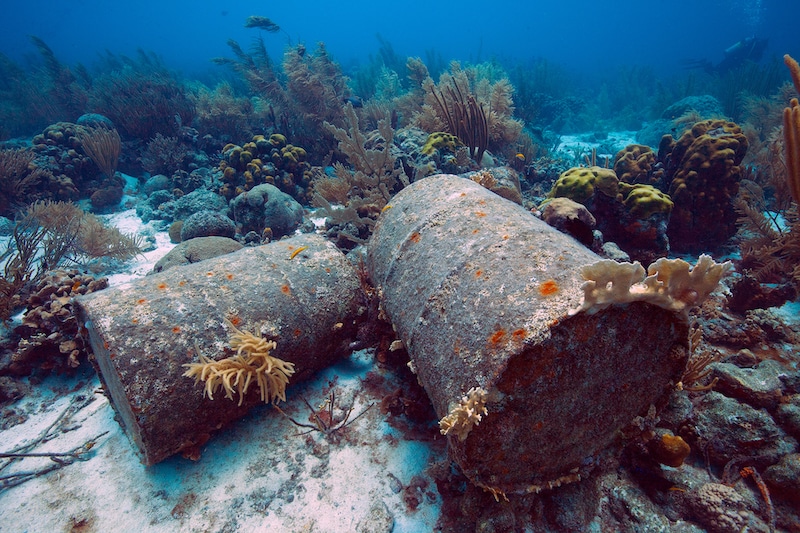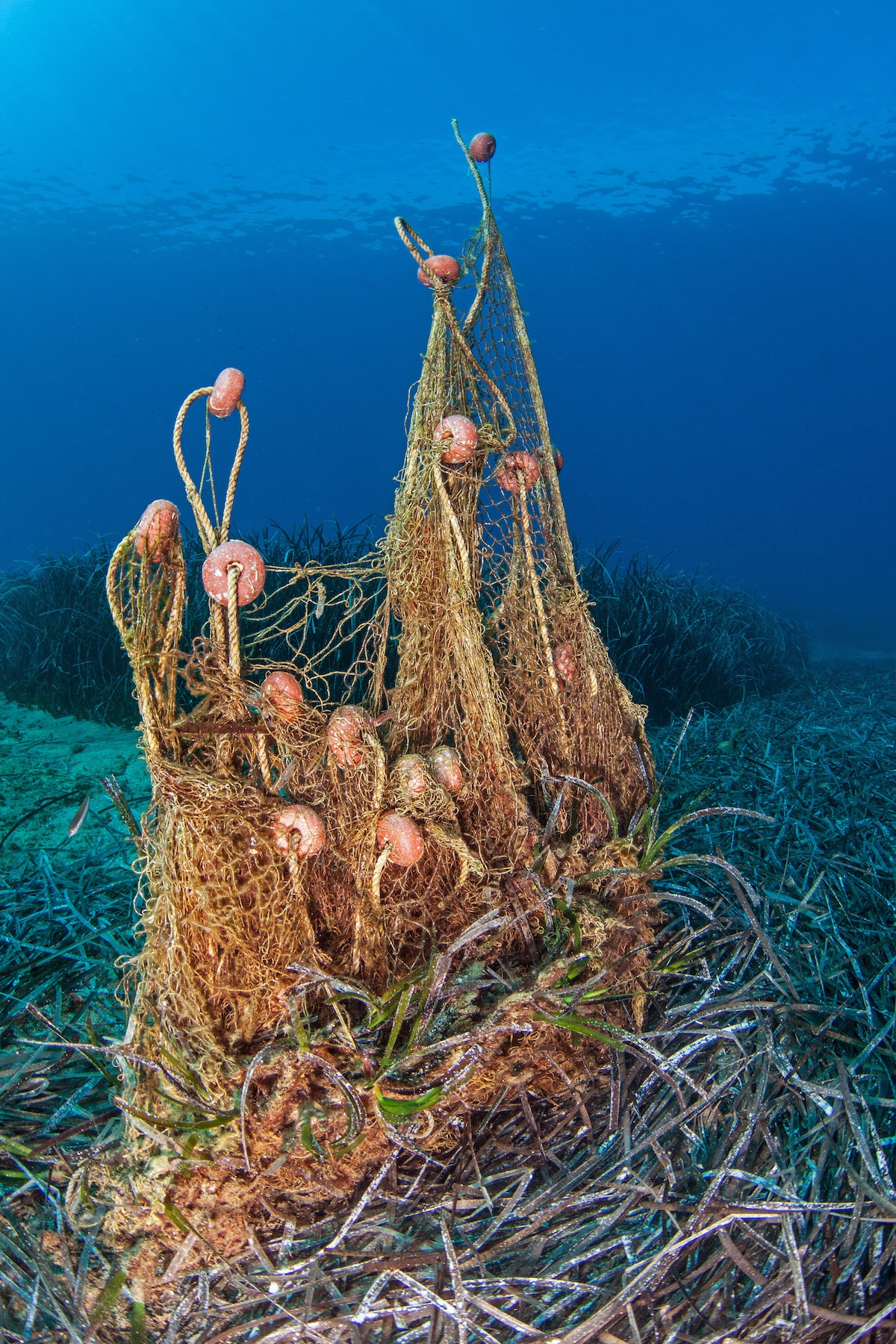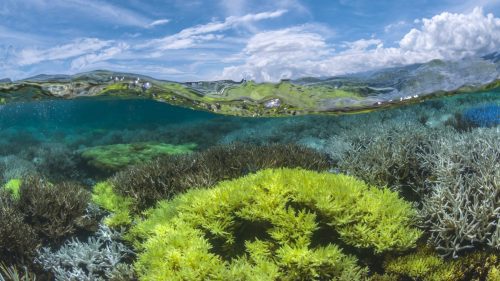The Treaths to the Ocean in 2022 and How to Prevent Them

The ocean covers 71% of the global surface, and functions as a life support system for the whole planet.
For centuries, we have assumed that the ocean’s resources were limitless, and that its vastness would be immune to human impact. We now know, however, that is not the case: over the last decades, scientists have uncovered the devastating effects our technologies and habits are having on marine ecosystems and life in general.
The time has come to take action and safeguard the ocean and the central role it has in the health of our blue planet. To do it, we must first understand what threats the ocean is facing right now, and how to prevent them.
Climate Change
The ocean and climate change are inextricably connected, and the latter is one of the main threats for marine health.
Rising temperatures are having huge impact on our oceans: coral reefs, for example, are extremely sensitive to warming waters, which is the reason why they are bleaching and dying.
Ocean Acidification
Another effect of global warming is ocean acidification, caused by the increased levels of carbon dioxide in the atmosphere: the water’s pH is constantly decreasing as the ocean absorbs higher levels of CO2. It has been shown that lower pH levels can affect the behavior of marine species, putting them at life-threatening risks.
Sea water levels rising
As we all know, global warming leads to the melting of glaciers around the globe and thus at sea-levels rising at an incredible speed. Additionally, the ocean is suffering the physical process of thermal expansion, for which water molecules are more distant among each other due to the increasing temperature. This poses a threat to both marine ecosystems and life on land, as it leads to wetland flooding, destructive erosion and agricultural land contamination as well as posing a threat to the habitats of land animals and plants.
Plastics and Ocean Debris
Studies show that more than 80% of marine pollution originates on land and is caused by direct human impact. An estimated eight million tons of plastic end up in our ocean each year.
The majority of plastic debris in the ocean is caused by littering: mainly disposable plastic items (food wrappings, plastic bags, razors, bottles, etc.) not disposed of properly, which end up in the waterways and eventually in the ocean.
Many plastics and microplastics are also the product of improper manufacturing processes.
At first, plastic pollution may stay in coastal waters, but it is soon picked up by rotating ocean currents (gyres), and transported literally all around the world.
This leads to the formation of what we call garbage patches, plastic accumulation areas in the center of the ocean’s gyres. The biggest is the Great Pacific garbage patch, between Hawaii and California.
Plastic pollution has a devastating impact on sea life and ecosystems. The most obvious one is the damage plastic items cause to animals, which include suffocation, entanglement, laceration, infections and internal injuries. Yet, plastic in the ocean also harms human beings, exacerbate climate change and is detrimental to the global economy.

Other Types of Pollution
Plastic is not the only type of pollution that threatens the balance and health of marine ecosystems. Still, most of the pollutants come from human activity and represent a serious threat to the ocean.
Nonpoint source pollution – Land Runoff
One of the other major sources of pollution is the waste that comes from land runoffs, precipitations, and atmospheric deposition.
Nonpoint source pollution comes both from urban and agricultural areas and consists in rainfall or snowmelts moving through the ground and picking up pollutants, eventually discharging them into lakes and rivers, which then carry them all the way to the ocean.
Oil Spills
Oil and chemical spills are defined as a type of point source pollution, as they come from a single source.
As we all know, crude oil has devastating effects on marine ecosystems for many years, and is very tricky to clean up.
Ocean Dumping
This is the direct discharge of pollutants in the ocean, can come from industries, ships and sewage plants, and can include:
- Waste from industrial plants, which is often toxic
- Effluent from sewage sent directly to the ocean
- Deliberate discharges from oil tankers that breach regulations
- Trash intentionally discarded into the sea
Fishing and Fishing Gear
Overfishing is incredibly destructive for the ocean, and it is threatening food security for millions of people. Fish that were once extremely common, such as bluefin tuna, are now becoming endangered species. Illegal and unregulated fishing practice cost the global economy up to $23 billion every year.
Subsidies given by governments to fisheries often only accelerate harmful overfishing, allowing vessels to fish harder for longer.
Fishing gear
Fishing leaves an incredible amount of harmful debris, which destroys habitats and threatens marine ecosystems.
Fishing nets are usually made of plastic and are often abandoned or lost: about 20% of the ocean’s plastic pollution comes from industrial fishing. Wildlife gets trapped in them or drags them for miles in their migrations.
Commercial Whaling
Yes, commercial whaling is still actually happening, and many species have been driven to the brink of extinction. Even if this practice is illegal almost everywhere, a few countries still carry it out. More than a thousand whales are killed annually for their meat and body parts to be sold for commercial gain and become ingredients in pharmaceuticals and health supplements.
Shipping and Transport
Maritime transport is part of a huge cluster of economic activities that create economic value, and we know that 90% of global trade currently uses sea routes.
However, shipping can be harmful for the ocean as the waste and trash generated by and on ships pollutes the waters.
Dredging
Dredging is an activity that enhances marine transportation, but it also represents a major disturbance for marine ecosystems by altering the composition of the ocean floor and soil, thus leading to the destruction of habitats.
NOx and SOx
Maritime transport is a big source of pollution: sea shipping is responsible for approximately 30% of total global NOx (nitrogen oxides) and SOx (sulfur oxides) emissions, which have been linked to thousands of premature deaths in coastal areas. Now, strict rules have been put into place to reduce their levels in transports emissions.
Ocean Noise
Oil spills and ocean dumping are not the only threats posed by the maritime transport industry.
The noise produced by shipping (and other industries, like drilling or military operations) has been demonstrated to be harmful for marine organisms. Marine life is extremely sensitive to noise, as many species rely on underwater sounds for basic life functions.

Offshore Drilling
High gasoline prices are leading to a renewed interest in offshore drilling, even if it is widely known that oil drilling platforms, pipelines and refineries generate both air and water pollution. The expansion of offshore drilling threatens the ocean as well as coastlines, and it carries the risk of more oil spills.
Deep-sea Mining
Exploration of deep-sea mining is rapidly giving way to exploitation of the ocean floor. As the deepest levels of the sea remain almost unexplored and poorly understood, we do not yet have a complete understanding of its biodiversity and ecosystems.
Scraping the ocean floor for precious minerals, such as gold, silver, copper, and zinc, can alter or destroy deep-sea habitats and therefore lead to the loss of species we have not even discovered yet.
What are the solutions?
The picture seems disastrous, but there is good news: all these threats to the balance of marine ecosystems can be mitigated and even prevented, it is not too late!
Let’s look at some of the main actions we can take to ensure a sustainable development and safeguard our ocean.
Establishing Marine Reserves
To this day, only 2% of the ocean is included in strongly protected marine reserves. Research estimates that we may need to protect up to 30% of our oceans to properly safeguard its health and future.
Marine reserves would preserve all kinds of marine life, from corals to sharks and whales, stopping unregulated fishing, drilling and mining to restore a pristine environment for all species to thrive undisturbed.
Reducing and Preventing Pollution
Research says that some of the most important changes we can work towards as a society are:
- eliminating coal combustion to reduce emission and, in turn, reduce mercury pollution;
- completely transitioning from fossil fuels to renewable energy as soon as possible;
- controlling the production of coastal pollution and involving local communities for a better monitoring of all processes;
- Implementing a ban on single-use plastic items, like straws and plastic bags, to reduce the amount of plastic in our environment. Habits are hard to change, but even a small individual will make a difference. According to data from the European Parliament, single-use plastics are responsible for 49% of all marine pollution.
Here are some new habits you could learn:
- Swap plastic bags for reusable ones.
- Reduce the use of disposable plastics like bottles and cups (bring your own!)
- Buy food and cleaning products in bulk to avoid wrappings.
- Choose metal or glass food containers and storage options.
- Avoid cosmetics that contain plastic microspheres or microbeads.

Eat less Fish (and meat!)
Fisheries and aquaculture cause major disturbances to the balance of marine ecosystems, also generating pollution and debris. In richer countries, we should try to eat less fish so that the ocean’s resources are not depleted and to minimize the environmental impacts of aquaculture.
In addition, intensive and industrial farming of animals is a massive cause of air and water pollution. Reducing our consumption of animal products can go a long way for the health of the planet and that of our ocean.
Sustainable Energy and Lower Emissions
As we have explained, climate change is inextricably linked to the way we treat our oceans. The focus in the following years should be on:
Decarbonizing maritime transport
As we have explained above, maritime transport is a huge source of pollution.
Thus, it is essential to work towards reducing shipping emissions effectively. The International Transport Forum report “Decarbonizing maritime transport” describes possible decarbonization pathways that use different measures to work towards that goal.
Developing Clean Ocean-based Energy
The ocean-based renewable energy revolution has begun. Now, all we need to work towards is increasing investments to enable the adoption of new technologies. Of course, with keen attention on minimizing the impact on marine ecosystems.
Research and Awareness
One of the main weapons we can use to stop these threats to marine environments is research. By deepening our understanding of how we relate to the ocean, individually and as a society, we can start implementing better habits and policies for all.
Research can also improve pollution monitoring, which would limit its effects on the planet and our health.
Publishing and spreading the results of research will help improve community engagement and awareness, which will in turn benefit the cause of fighting for the safeguarding of our ocean.
Professor Philip Landrigan, the director of the observatory and of BC’s Global Public Health and the Common Good Program said, “The key thing to realize about ocean pollution is that, like all forms of pollution, it can be prevented using laws, policies, technology, and enforcement actions that target the most important pollution sources”.
Let us start. It is not too late!
Resources
https://www.ifaw.org/journal/five-biggest-threats-to-ocean
https://www.weforum.org/agenda/2018/06/5-ways-we-can-improve-ocean-health/
https://www.nationalgeographic.com/environment/article/ocean-threats
https://www.nrdc.org/issues/ocean-threats
https://www.greenpeace.org/usa/oceans/issues/
https://www.marineinsight.com/environment/11-threats-to-marine-environment-you-must-know/
https://worldoceanreview.com/en/wor-4/how-the-sea-serves-us/oceans-under-threat/



